Small Scaly Patch On Skin That Bleeds If Scratched

13 Reasons You Have Scaly Skin—and How to. Typically appears as scaly patches on areas of the body that. Can bleed if bumped, scratched, or scraped. Itchy scalp that bleeds. In my left ear canal, there is another patch of the same thing! And become really itchy, I scratch them so much my skin bleeds and.
Contact Dermatitis is an allergic reaction to something you’ve touched. Health and beauty products like shampoo, hair dye, or jewelry can cause an.
Certain materials, like, can also lead to a reaction. So can outdoor foliage, such as. You may have a bad reaction if like battery acid or bleach touch your scalp. An allergic reaction can cause your scalp to develop dry that itch or burn. If you scratch, you can cause bleeding and scabbing.
Your scalp should clear up on its own, but see your doctor if the area appears infected, is getting more painful, or is spreading. Be very careful to avoid coming into contact with the irritant again. Allergic reactions can grow stronger with multiple exposures. Seborrheic Dermatitis (Dandruff) Seborrheic dermatitis is a skin condition that can affect your scalp. Hasp Sentinel here.
Symptoms include, flaking, and scabbing. Crusty patches of skin are usually white or yellow and can attach to the hair shaft. The cause is not clear, but it has nothing to do with cleanliness. You can shampoo your hair every day and still have. Even newborn babies can have it (cradle cap). It’s not contagious, and it isn’t usually a sign of poor health. Unfortunately, it can take a long time to get dandruff under control.
In some cases, it may become a lifelong problem that comes and goes. You can buy over-the-counter and topical ointments designed to. If that doesn’t help, there are some prescription medications you can try. Some of these drugs can have side effects, so be sure to follow package directions carefully. Report any problems to your doctor or pharmacist. Lichen Planus (Lichen Planopilaris) is an ailment that causes red or purple bumps on the skin.
When it affects the scalp, it’s called lichen planopilaris. It can lead to permanent scarring and (alopecia). Anyone can get lichen planus, but it’s more likely to strike in middle age. It can sometimes be diagnosed by its appearance.
A skin biopsy can confirm the diagnosis. Most of the time, there’s no known cause. It sometimes clears up on its own, but it can persist for years.
Treatment usually involves topical corticosteroid creams or oral steroids. In some cases, injectable steroids may be more helpful. If left untreated, lichen planopilaris can lead to hair loss, which may be permanent. Can help with the itching. Head Lice Nobody likes the idea of. As unnerving as they are, the good news is that they don’t carry disease or cause any major health concerns.
If you have head lice, you’ll probably feel something moving on your scalp, as well as itching. If you scratch too much, you’ll end up with scabs on your scalp, which can lead to infection. If someone in your household has head lice, everyone who has been in close physical contact should be checked. Head lice can be treated with specifically designed, over-the-counter medications. Another bit of good news is that head lice don’t live long once they fall off or are removed. They generally survive less than two days when they can’t feed.
Make sure to wash any bedding, clothing, and furniture that the infested person used during the two days before treatment. Use hot water for laundry and dry in high heat.
Other items can be dry-cleaned. For items you can’t wash, closing them up in a plastic bag for two weeks will take care of adult lice and their offspring. The (CDC) suggests soaking hairbrushes and combs in 130 F water for 5 to 10 minutes.



